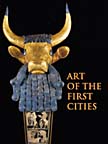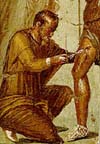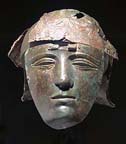Alexander the Great has been both glorified and villified by Roman politicians and philosophers seeking to effect a particular public personae. I found this interesting paper on the topic by Diana Spencer, St. Johns College, Cambridge:
She points out the dilemma of using this "legend" to interpret and formulate governmental structure "during periods of political flux":
"Alexander can never be as effective as a consul because he is a king, and kings have no checks placed upon their whims; paradoxically, this detrimental lack of struggle is also represented as an advantage: the monarch does not follow in the train of circumstance, he controls the destiny of his state." (referring to Livy IX.18.13-16).
During the civil war between Octavian and Antony, Octavian actively sought to portray himself as an Alexandrian image-conscious ruler:
"The need to create a political and visual vocabulary for the emerging post-Caesarian power structure was initially defined as much by emphasis on what Antony was not, as by what Octavian sought to introduce. Alexanders control of his own image--or at least, his reputation as an image-conscious ruler--serves as a boundary to acceptable Roman-ness in terms of Antony versus Octavian, but also as a potential intellectual model for how an emperor might want to be portrayed, and how to comment on this scenario."
Senecas view of Alexander was more villainous but this became a problem using Alexander as the example when evaluating the behavior of Nero in comparison.
"Senecas involved voice is characterised by this question: what man would destroy the source of his own education?; the overt subject is Alexanders treatment of Greece, but beneath the surface simmers a sub-text, dealing with the madness of a pupil who robs his tutor of the voice and attributes with which he was taught [Ep. ad Luc. 94.62-63]. Because the Roman image of Alexander shows him as excessive (and unsuccessful) in his eastward campaign, there are inherent difficulties for Seneca in his use; Romans also seek eastern dominion, and Nero had Alexandrian hankerings; this parallel could also be read as a comment on the prince who exceeds the teachings of his mentor and ends by ascribing to contradictory views. How suitable a model is this Alexander for a Roman emperor when (even though his youth is seen in terms of pupillage and education) potential madness and self-destruction haunt visions of his later career? "
Subsection of Roman Times:
A weblog of links to and abstracts from academic presentations on the Roman Empire
Sunday, May 25, 2003
"Art of the First Cities: The Third Millennium B.C. from the Mediterranean to the Indus" at NY Met
 "Art of the First Cities: The Third Millennium B.C. from the Mediterranean to the Indus" explores the emergence of the worlds first city-states and empires in Syria and Mesopotamia during the third millennium B.C. and relates these developments to artistic and cultural connections stretching from the eastern Aegean to the Indus valley and Central Asia. Over 400 works of art illustrate the splendor of the most famous sites of the ancient world including the Royal Graves of Ur, the palace and temples of Mari, the citadel of Troy, and the great cities of the Indus Valley civilization.
"Art of the First Cities: The Third Millennium B.C. from the Mediterranean to the Indus" explores the emergence of the worlds first city-states and empires in Syria and Mesopotamia during the third millennium B.C. and relates these developments to artistic and cultural connections stretching from the eastern Aegean to the Indus valley and Central Asia. Over 400 works of art illustrate the splendor of the most famous sites of the ancient world including the Royal Graves of Ur, the palace and temples of Mari, the citadel of Troy, and the great cities of the Indus Valley civilization.
Monday, May 12, 2003
"Stories of An Eruption: Pompeii, Herculaneum, & Oplontis" Exhibit In Naples Until August 31, 2003
 Body casts and artifacts from the sites of Pompeii, Herculaneum and Oplontis, devastated by the eruption of Mt. Vesuvius in 79 A.D., are now on exhibit at the National Archaeological Museum in Naples until August 31. The exhibit then moves to Musees Royaux dArt et dHistoire in Brussels from Oct. 9 to Feb. 8, 2004.
Body casts and artifacts from the sites of Pompeii, Herculaneum and Oplontis, devastated by the eruption of Mt. Vesuvius in 79 A.D., are now on exhibit at the National Archaeological Museum in Naples until August 31. The exhibit then moves to Musees Royaux dArt et dHistoire in Brussels from Oct. 9 to Feb. 8, 2004.
Comparatively few inhabitants of Herculaneum remained to be caught by this blast, since most had had the opportunity to flee. During the 1980s, however, a new excavation of the towns harbor area uncovered a series of barrel-vaulted sheds along a beach, seemingly used to keep boats and fishing tackle. About 300 people had sought refuge in these shelters, and although they were protected from the full force of the volcano's first surge, they died soon after from the intense heat and toxic gases. The exceptionally detailed cast (thanks to modern techniques) of a group preserved in the agonized throes of death, is the exhibition's most nightmarish display. Among the individuals in the boathouses were a doctor or surgeon, who was carrying a set of instruments strikingly similar to their present-day equivalents, and a soldier, who had with him his weapons and a knapsack containing tools.
Many ancient frescoes are exhibited for the first time. Three complete dining rooms have been reconstructed with nine walls of frescoes from a villa in Moregine, a suburb of Pompeii, where the Emperor Nero visited. Another reconstructed dining room from a villa in nearby Terzigno--its entire length opening onto a portico--features extraordinarily fine frescoes of mythological scenes in Pompeiis architectural style. The owners sold their estate to a wine and olive-oil producer after the earthquake of A.D. 62, an omen of the eruption to come.
The show also includes an incredibly detailed scale model from 1879 of the excavations with a retrospective of paintings, literature and film clips--even a psychoanalytical study by Sigmund Freud--inspired by the eruption since Pompeiis rediscovery in the 18th century.
See also: http://www.time.com/time/europe/magazine/article/0,13005,901030519-450959,00.html
Roman battlefied medicine not surpassed until the 20th century
 I watched an interesting program on The History Channel about combat medicine through the centuries and it was very favorable towards Roman battlefield medicine. The Roman used silver wound staples because they are hypoallergenic and their surgical clamps were almost identical to clamp design in modern 21st century hospitals.
I watched an interesting program on The History Channel about combat medicine through the centuries and it was very favorable towards Roman battlefield medicine. The Roman used silver wound staples because they are hypoallergenic and their surgical clamps were almost identical to clamp design in modern 21st century hospitals.
An excellent site by a physicians daughter,Tanya Marton, pointed out that Augustus founded the first professional army medical corps.
"Augustus, realizing that they were key in an empire and especially an army, gave all physicians that joined his new army medical corps dignified titles, land grants, and special retirement benefits!. . . At the beginning of the first century, all army doctors were required to attend the new army medical school, and by the third century, all doctors, both civilian and army, were required to pass medical school."
"Interestingly, the Romans did not yet really understand how germs related to disease, but they did use many of the techniques that killed germs, techniques that were not reinvented until much later. For example, they boiled their tools before use and would not reuse the same tool on a patient before reboiling. Wounds were washed with "acetum," which is actually a better antiseptic than Joseph Listers carbolic acid (Joseph Lister rediscovered antiseptics in the 1860s, based on Louis Pasteurs brand-new germ theory of disease). "
"Over the years, Roman war doctors also learned how to prevent many battlefield epidemics. They accomplished this by placing forts AWAY from insect infested swamps. They also installed drains and sewers to transport sewage away from the men. Similarly, they invented sophisticated permanent hospitals, with specialized rooms for different tasks, and with isolation of some patients from others to reduce the spread of disease. Central heating and good ventilation also helped patients."
The Roman also introduced the battlefield "medic": "One Roman innovation was providing limited medical training to certain soldiers who remained with the troops. These soldiers functioned as combat medics who provided far-forward care to injured soldiers, such as using bandages to control bleeding. The army also had special units which evacuated soldiers from the battlefield to the field hospitals where they were treated by medical personnel."
Jenny Booth of the London Telegraph reported the discovery of a Roman-amputated thigh bone in October, 2000. The femur was found in a tomb near the city of Portus in Italy. (http://omega.cohums.ohio-state.edu/hyper-lists/classics-l/00-11-01/0301.html)
"THE first evidence that doctors in ancient Rome were able to carry out successful amputations has been uncovered by anthropologists. A 2nd
Century thigh bone found in a cemetery near Rome clearly shows the serrated marks of a surgeons saw. The amputee was a tall man who must
have survived for months or even years after his operation, because the bone had started to heal. This suggests that the surgeons were skilled
enough to fashion a flap of tissue to sew over the amputated end, protecting it from the air. "
Thursday, May 08, 2003
Purple Dye and Its Importance In The Ancient World
 I have been listening to lectures on the history of ancient Egypt, a Teaching Company course presented by Professor Bob Brier. In the last of my 48 lectures on ancient Egypt, Dr. Brier mentioned an interesting detail about Cleopatras daughter by Marc Antony, Cleopatra Selene. Apparently, Cleopatra Selene married King Juba of Mauretania and had two children, a son and a daughter. Cleopatra and Juba had developed a thriving export business due to the high concentration of murex snails in the waters off the coast of Mauretania. Murex snails are the source of one of the best dyes in the ancient world. Anyway, Cleopatras son, Ptolemy, decided to travel to Rome to visit his cousin Caligula. Ptolemy wore a rich purple cloak dyed with his familys trademark product. When he got to Rome, Caligula was so upset that Ptolemys cloak was such a richer purple than his own that he had Ptolemy killed.
I have been listening to lectures on the history of ancient Egypt, a Teaching Company course presented by Professor Bob Brier. In the last of my 48 lectures on ancient Egypt, Dr. Brier mentioned an interesting detail about Cleopatras daughter by Marc Antony, Cleopatra Selene. Apparently, Cleopatra Selene married King Juba of Mauretania and had two children, a son and a daughter. Cleopatra and Juba had developed a thriving export business due to the high concentration of murex snails in the waters off the coast of Mauretania. Murex snails are the source of one of the best dyes in the ancient world. Anyway, Cleopatras son, Ptolemy, decided to travel to Rome to visit his cousin Caligula. Ptolemy wore a rich purple cloak dyed with his familys trademark product. When he got to Rome, Caligula was so upset that Ptolemys cloak was such a richer purple than his own that he had Ptolemy killed.
Murex was a highly valued source of dye in the ancient world. I found this excellent collection of papers about it.
"Although Pliny describes many varieties of purple, there were just two main categories, Hyacinth Purple and Tyrian Purple, that were produced from different species of shellfish: the former from banded dye-murex (Ph. trunculus) and the latter mainly from spiny dye-murex (B. brandaris)," writes Irving Zidernman. "The controversy as to whether banded dye-murex produces a unique violet (hyacinth) colour or the same purple hue as Tyrian purple has raged since the dye source was rediscovered in the 1830s."
Brendan Burke writes, "According to Julius Pollux (Onomasticon I, 45-49), writing in the second century AD, purple dye was first discovered by Herakles, or rather, by his dog, whose mouth was stained purple from chewing on snails along the Levantine coast, the area most famous in antiquity for its purple dye. Palaephatus (De Incred 62) also attributes the discovery of purple dye to Herakles and locates it at Tyre in the mid-second millennium B.C. King Phoenix received a purple-dyed robe from Herakles and decreed that the rulers of Phoenicia should wear this colour as a royal symbol.
Although the Levantine coast and the people of Tyre were renowned for their purple in antiquity, the earliest archaeological evidence for purple-dying from sea-snails in the Mediterranean is found on Crete. The earliest known deposits of murex shells on Crete, in quantities substantial enough and worn in such a way as to suggest dye-extraction, occur on the small island of Kouphonisi, at Palaikastro, and at Kommos. Pottery found at these sites suggests a date within the early Middle Minoan period, ca. 20th-18th c. B.C. Slightly later finds of murex shells occur elsewhere in the Aegean, at Troy, and in the Levant.
See also: http://www.convertingloop.com/cgi-bin/cl.pl/db_area/converting/paper_film_foil/2002/pffc20020701.1.shtml
Tuesday, May 06, 2003
New Language Study Sparks Debate Between Linguists and Archaeologists
The invention of agriculture has long been invoked to explain the spread of the Indo-European languages. Now, Dr. Jared Diamond of the University of California at Los Angeles and Dr. Peter Bellwood of the Australian National University in Canberra have applied the concept to 15 major language families. Their article appeared in the April 25 issue of Science.
The premise is that when humans lived as hunters and gatherers, their populations were small, because wild game and berries can support only so many people. But after an agriculture system was devised, populations expanded, displacing the hunter-gatherers around them and taking their language with them.
On this theory, whatever language happened to be spoken in a region where a crop plant was domesticated expanded along with the farmers who spoke it.
Even if the farmers interbred with the hunter-gatherers whose land they took over, genes can mix, but languages cannot. So the hunter-gatherers would in many cases have adopted the farmers language. That is why languages "record these processes of demographic expansion more clearly than the genes," Dr. Bellwood said.
Dr. Diamond said the new theory also predicted that expansions would occur more easily on an east-west axis than a north-south axis because the crop plants on which an agriculture depends tend to be able to grow only at particular latitudes.
The premise is that when humans lived as hunters and gatherers, their populations were small, because wild game and berries can support only so many people. But after an agriculture system was devised, populations expanded, displacing the hunter-gatherers around them and taking their language with them.
On this theory, whatever language happened to be spoken in a region where a crop plant was domesticated expanded along with the farmers who spoke it.
Even if the farmers interbred with the hunter-gatherers whose land they took over, genes can mix, but languages cannot. So the hunter-gatherers would in many cases have adopted the farmers language. That is why languages "record these processes of demographic expansion more clearly than the genes," Dr. Bellwood said.
Dr. Diamond said the new theory also predicted that expansions would occur more easily on an east-west axis than a north-south axis because the crop plants on which an agriculture depends tend to be able to grow only at particular latitudes.
Monday, May 05, 2003
Teutoburg Battle Subject of New Exhibition
 The worst defeat to strike the Roman empire is subject of new exhibition at Archeological Museum Frankfurt. Artifacts found the ravines, thick forests, marshlands and bogs at the foot of the Kalkriese hillwhere the Teutons trapped the armies of the Roman governor Varus north of the present-day Lower Saxony city of Osnabruck will be displayed. Some 6,000 relics have been excavated since a British amateur archeologist unearthed a couple of Roman catapult projectiles and coins in 1997. These artifacts include bones, weapons, everyday utensils, jewelry and coins. Some of the coins bear the mark VAR, for Varus, and historians have confirmed with certainty that they were minted between AD 6 and AD 9.
The worst defeat to strike the Roman empire is subject of new exhibition at Archeological Museum Frankfurt. Artifacts found the ravines, thick forests, marshlands and bogs at the foot of the Kalkriese hillwhere the Teutons trapped the armies of the Roman governor Varus north of the present-day Lower Saxony city of Osnabruck will be displayed. Some 6,000 relics have been excavated since a British amateur archeologist unearthed a couple of Roman catapult projectiles and coins in 1997. These artifacts include bones, weapons, everyday utensils, jewelry and coins. Some of the coins bear the mark VAR, for Varus, and historians have confirmed with certainty that they were minted between AD 6 and AD 9.
The exhibition runs at the Archeological Museum Frankfurt until Sept. 14.
Subscribe to:
Comments (Atom)